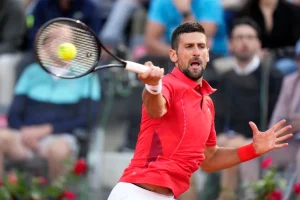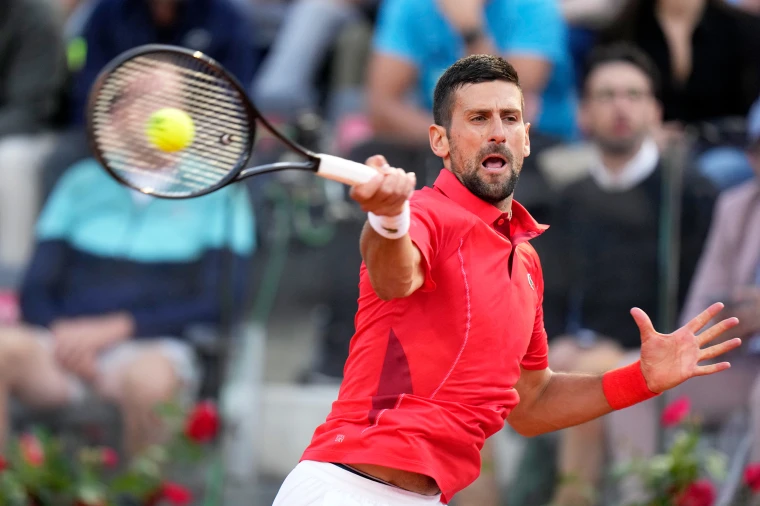
There is a difference between being in a dazed state, and actually getting knocked out. On Sunday, Serbian star Novak Djokovic lost to unsung Alejandro Tabilo in straight sets at the Italian Open in Rome, but the bigger story was how he had been “felled” by the water bottle which landed on his head three nights earlier.
When Djokovic was signing autographs after his win over Corentin Moutet in Rome, there was a scare and then chaos. A fan’s water bottle landed on Djokovic’s head and the player fell to the ground. After receiving medical attention, he went back to his hotel room. There was even some amusement from the dramatis personae that Djokovic is, as he came to the tennis court the next day wearing a helmet. If that was an attempt at wry humour, what happened on Sunday was bizarre.
Against Tabilo, Djokovic was in trouble. Any tennis player can have an off day, as suggested by his uncharacteristic 22 unforced errors and five double-faults. Yet, anyone who has followed the illustrious career of the winner of 24 Grand Slam titles will vouch that such inconsistency is rare. This, surely, was more than an aberration. Djokovic was not 100 per cent on court. For those who had seen him compete at the Australian Open in 2023 and win the title despite a tear in his left hamstring, stories of him withstanding the pain barrier are well known.
But then, for all those who think that the injury in January last year and the current situation – suffering from nausea and dizziness on court on Sunday – are the same are way off the mark. To be sure, the recent incident is more than a scare for Djokovic, who is looking forward to defending his French Open title in Paris a fortnight from now.
“I think in the video, you saw it very clearly,” said the Serbian, after his loss on Sunday. Anyone who has followed Djokovic knows he never makes excuses. The water bottle had landed on his head from a height and the velocity caused him trauma, if not grief.
RevSportz spoke to a few tennis writers in Europe and the unanimous view was that Djokovic was dealing with some issues, though not serious, after the water-bottle incident. “It was a very unfortunate situation for me, ” he told reporters. “It was an accident where the guy leaned over the fence and the bottle from his rucksack landed on my head.”

The few tennis writers who watched the incident and wrote on it have confirmed there were after-effects. “It has impacted me a lot, dizziness, nausea and some different things,” said Djokovic.
Even though he slept on the night of the incident, despite a headache, the after-effects were felt on Sunday. “The way I felt on court on Sunday was completely different, no rhythm, no tempo, no balance,” said Djokovic.
Just to jog the readers’ memory, there are two incidents from tennis history which shook both players and passionate fans. The first was in 1993, when Gunter Parche, a die-hard Steffi Graf fan, stabbed Monica Seles in her back in Hamburg. Parche was unhinged, and knifed Seles as he could not tolerate her success. That Seles lost many tennis years due to that incident is well known. More than just the physical pain, the mental agony which Seles underwent was intense. It went on for several years, where she was unsure if some other madman would also do something.
Seles handled the trauma bravely but after that stabbing incident, life was never the same for her. This writer had interacted with Seles in a group interview, and what she emphasised was not just the physical pain but the mental scar and scare. Parche died a couple of years ago at a nursing home in Germany.
The Seles incident and Novak accident are different in nature, but the scare and fear cannot be quantified. For a man who has seen war and strife as a young boy in Serbia, Djokovic is aware of ugly things. That’s why even when the media tried to drag Novak and his father Srdjan into the Russia-Ukraine war debate last year at the Australian Open in January, he was careful with words.
Then again, how does one forget another crazy incident where Czech star Petra Kvitova was stabbed in her flat in December 2016 by Rodim Zondra. Kvitova had to actually fight to save her life, as Zondra had a knife and held it at her throat. Kvitova had testified in court after the incident that there was blood all over in her flat. She did make a comeback to tennis after five months, as her hand was cut badly. But then, it was never easy to fight the mental scars.
One can easily say that Djokovic will be fine and ready for the French Open. That is not the point. He has interacted with tennis fans around the globe in a brilliant way. But can one remove fear from his head and heart in three days or a week? No, there is bound to be apprehension that some object may be aimed at him, even if unintentionally.
It’s easy for illiterate tennis fans to say these things happen in sport, where an athlete is hit, even as an accident. However, for Djokovic, how he handles the current situation will be challenging. Medically, he will have the best facilities. But then, there is no quick treatment for a psychological scar.




